John Hurrell – 25 April, 2010
Laing has made an exceptionally interesting combination pairing these two artists together. So is about observation and perception and Cripp the duration of time and gradual geological motion.
Auckland
Sculpture Season 2010
Curated by Melissa Laing
Agnes So and Anthony Cribb
22 April - 1 May 2010
In this last (sixth) presentation of a series of sculptural projects by mainly recent AUT graduates - organised by Melissa Laing - Agnes So occupies most of Gallery Three’s bunkerish space while Anthony Cribb has a large lidlike tray at the far end, suspended high up near the ceiling. His flat shallow box is held there by wooden struts and slightly spindly legs, and contains a mini-landscape of hillock forms projecting out of a pool of black water. The lumpy forms are made of sand and bitumen.
Cribb’s dark gritty mounds are built with the expectation they’ll soon subside. The saturated sand will shift under the crumbly bitumen and the moving sludge will slowly even out. This impending collapse is exacerbated by small vibrations from the passing Symonds Street traffic which continually shake the laden structure. At the end of the month the swampy ‘geology’ should look notably different from what it does now.
Cribb likes to tease his audience though, for the height will prevent many (less tall people) from seeing the tray’s contents. They will have to imagine the details. Because this comparatively (visually) inaccessible component of Cribb’s work is not stable anyway, that makes such reliance on mental fantasies extra perverse - if not sadistically funny. He seems to be mocking elucidated ‘factual description’ and spotlighting the limitations of language.
Agnes So’s items, in contrast to Cribb’s elegant raised platform, are Heath Robinsonish and rickety. However, like his they demonstrate an interest in the laws of physics, using the weight of her precariously balanced materials to hold something in place - or taut lines (traversing space) to exert tension. Often she teases with decoys, deliberately misleading her audience. For example many of her physically slight constructions seem to be vertically held up by long lines of glistening nylon that sparkle under the gallery lights. You are meant to see them.
One of these threads goes through a circular hole in an almost teetering board, implying that it exerts an antigravitational tension, but in fact it doesn’t touch the opening’s sides. The rectangle’s equilibrium is actually securely maintained by chocks at the base. In another work, a brown cardboard oblong is taped on its edge to a long vertical line of joined balsa sticks that help it balance on the top edge of a wall that partially blocks out the windows. The line of attached sticks runs down to the floor and across it - far longer than necessary to keep the cardboard stable. The horizontal part of the balsa line is superfluous, a deliberate overstatement, as the vertical length - though light - has sufficient weight on its own to do the job.
At the other end of the same top edge of the same long wall a un-nailed baton of timber pinions down a loose photocopy hanging down the side. The image shows a solid mapping pin resting on top of a sheet of paper with its sharp tip almost touching a folded paper crease but not impaling it.
Nearby is a weighed-down, balsa-sticked ‘flag’ with a photograph attached at its top. It looks like a dark hole in its centre until you realise it is a solid grey rock attached to yet another inverted (perhaps the same) flag. So enjoys making reflexive jokes about the work’s own construction.
She also presents a short film projected onto a low, small L-shaped wall. It shows a brown plastic rectangular cushion cover that has been squished up into a tight ball and released to slowly unravel. In parts of the film it seems to be speeding up and even inflating and ballooning out with pumped in air - not just relaxing into its natural uncompressed form. Eventually it topples off its stand which happens to be an inverted cardboard carton for a reading lamp, making some sort of pun about ‘lightness’ and instability. The process of a moving body gradually changing as it approaches stasis makes a nice link to Cribb’s project down the other end of the space, and its high placement on a supporting structure.
Laing has made an exceptionally interesting combination pairing these two artists together. While So is about observation and perception and Cripp the duration of time and gradual geological motion, they both delight in examining instability and temporality, mixing their interest with a mischievous humour. Well worth a visit.
John Hurrell
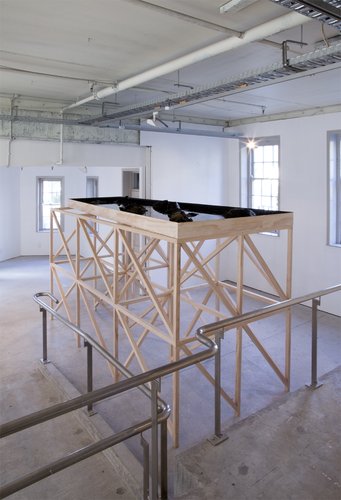

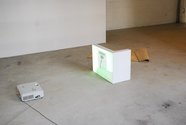
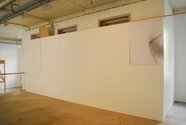

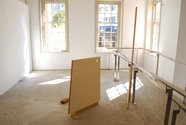
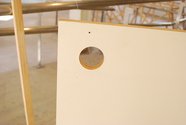
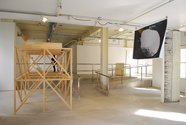
 Two Rooms presents a program of residencies and projects
Two Rooms presents a program of residencies and projects Advertising in this column
Advertising in this column



This Discussion has 0 comments.
Comment
Participate
Register to Participate.
Sign in
Sign in to an existing account.